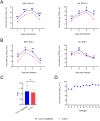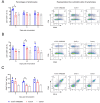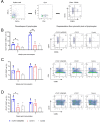A recombinant rabies virus chimera expressing the DC-targeting molecular MAB2560 shows enhanced vaccine immunogenicity through activation of dendritic cells
- PMID: 37093869
- PMCID: PMC10124880
- DOI: 10.1371/journal.pntd.0011254
A recombinant rabies virus chimera expressing the DC-targeting molecular MAB2560 shows enhanced vaccine immunogenicity through activation of dendritic cells
Abstract
Background: Rabies, caused by the rabies virus (RABV), is an ancient and neglected zoonotic disease posing a large public health threat to humans and animals in developing countries. Immunization of animals with a rabies vaccine is the most effective way to control the epidemic and the occurrence of the disease in humans. Therefore, the development of cost-effective and efficient rabies vaccines is urgently needed. The activation of dendritic cells (DCs) is known to play an important role in improving the host immune response induced by rabies vaccines.
Methodology/principal findings: In this study, we constructed a recombinant virus, rCVS11-MAB2560, based on the reverse genetic system of the RABV CVS11 strain. The MAB2560 protein (a DC-targeting molecular) was chimeric expressed on the surface of the viral particles to help target and activate the DCs when this virus was used as inactivated vaccine. Our results demonstrated that inactivated rCVS11-MAB2560 was able to promote the recruitment and/or proliferation of DC cells, T cells and B cells in mice, and induce good immune memory after two immunizations. Moreover, the inactivated recombinant virus rCVS11-MAB2560 could produce higher levels of virus-neutralizing antibodies (VNAs) in both mice and dogs more quickly than rCVS11 post immunization.
Conclusions/significance: In summary, the recombinant virus rCVS11-MAB2560 chimeric-expressing the molecular adjuvant MAB2560 can stimulate high levels of humoral and cellular immune responses in vivo and can be used as an effective inactivated rabies vaccine candidate.
Copyright: © 2023 Gong et al. This is an open access article distributed under the terms of the Creative Commons Attribution License, which permits unrestricted use, distribution, and reproduction in any medium, provided the original author and source are credited.
Conflict of interest statement
The authors have declared that no competing interests exist.
Figures









Similar articles
-
Incorporation of Escherichia coli heat-labile enterotoxin B subunit into rabies virus particles enhances its immunogenicity in mice and dogs.Biosaf Health. 2023 May 9;5(5):308-319. doi: 10.1016/j.bsheal.2023.05.005. eCollection 2023 Oct. Biosaf Health. 2023. PMID: 40078911 Free PMC article.
-
A novel inactivated oral rabies vaccine with the incorporation of U-OMP19 enhances the immunogenicity by reducing viral proteins degradation and activating dendritic cells in a mouse model.Vet Microbiol. 2024 Nov;298:110287. doi: 10.1016/j.vetmic.2024.110287. Epub 2024 Oct 28. Vet Microbiol. 2024. PMID: 39471657
-
A single dose of an ALVAC vector-based RABV virus-like particle candidate vaccine induces a potent immune response in mice, cats and dogs.Emerg Microbes Infect. 2024 Dec;13(1):2406280. doi: 10.1080/22221751.2024.2406280. Epub 2024 Sep 30. Emerg Microbes Infect. 2024. PMID: 39295522 Free PMC article.
-
An inactivated recombinant rabies virus chimerically expressed RBD induces humoral and cellular immunity against SARS-CoV-2 and RABV.Virol Sin. 2023 Apr;38(2):244-256. doi: 10.1016/j.virs.2022.12.006. Epub 2022 Dec 29. Virol Sin. 2023. PMID: 36587795 Free PMC article.
-
Research Advances on the Interactions between Rabies Virus Structural Proteins and Host Target Cells: Accrued Knowledge from the Application of Reverse Genetics Systems.Viruses. 2021 Nov 16;13(11):2288. doi: 10.3390/v13112288. Viruses. 2021. PMID: 34835093 Free PMC article. Review.
Cited by
-
Vaccine Strategies Against RNA Viruses: Current Advances and Future Directions.Vaccines (Basel). 2024 Nov 28;12(12):1345. doi: 10.3390/vaccines12121345. Vaccines (Basel). 2024. PMID: 39772007 Free PMC article. Review.
References
-
- Gonzalez-Roldan JF, Undurraga EA, Meltzer MI, Atkins C, Vargas-Pino F, Gutierrez-Cedillo V, et al.. Cost-effectiveness of the national dog rabies prevention and control program in Mexico, 1990–2015. PLoS neglected tropical diseases. 2021;15(3):e0009130. Epub 2021/03/05. doi: 10.1371/journal.pntd.0009130 ; PubMed Central PMCID: PMC7963054. - DOI - PMC - PubMed
-
- Yamada A, Makita K, Kadowaki H, Ito N, Sugiyama M, Kwan NCL, et al.. A Comparative Review of Prevention of Rabies Incursion between Japan and Other Rabies-Free Countries or Regions. Japanese journal of infectious diseases. 2019;72(4):203–10. Epub 2018/12/26. doi: 10.7883/yoken.JJID.2018.431 . - DOI - PubMed
-
- Fernandes MES, Carnieli P Jr., Gregório ANF, Kawai JGC, Oliveira RN, Almeida LL, et al.. Phylogenetic analysis of rabies viruses isolated from cattle in southern Brazil. Virus genes. 2020;56(2):209–16. Epub 2020/01/20. doi: 10.1007/s11262-020-01730-y ; PubMed Central PMCID: PMC7223090. - DOI - PMC - PubMed
-
- Benavides JA, Velasco-Villa A, Godino LC, Satheshkumar PS, Nino R, Rojas-Paniagua E, et al.. Abortive vampire bat rabies infections in Peruvian peridomestic livestock. PLoS neglected tropical diseases. 2020;14(6):e0008194. Epub 2020/07/01. doi: 10.1371/journal.pntd.0008194 ; PubMed Central PMCID: PMC7351222. - DOI - PMC - PubMed
Publication types
MeSH terms
Substances
LinkOut - more resources
Full Text Sources
Medical

